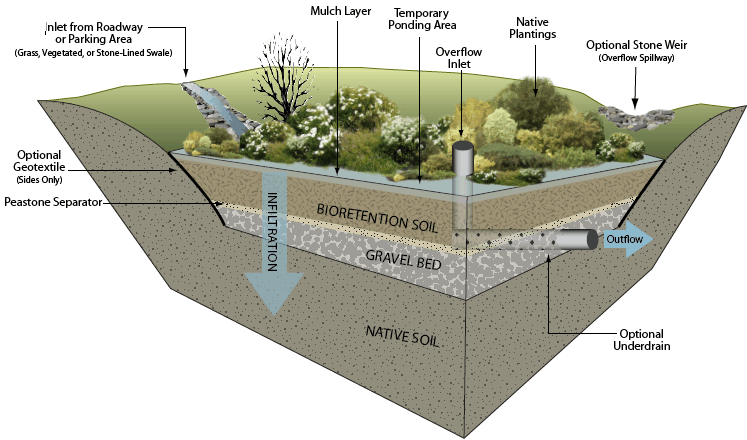USGS Nebraska Water Science Center
Monitoring the Effectiveness of Bioretention Cells
What is Green Infrastructure?
Green infrastructure, or Low-Impact Development (LID), is the use of plants and soils to capture, retain, and filter stormwater. Green infrastructure is used as part of a stormwater management plan to reduce the amount of stormwater being released into the sewer system. In cities like Omaha, storm sewers and sanitary sewers are collected in one pipe that goes to the wastewater treatment plant. During storm runoff events, the pipe system cannot hold all the water, and as a result untreated sewage is discharged directly into the stream. This type of pipe system is called a combined sewer overflow (CSO). Rainfall of more than 0.1 inches can cause raw sewage to be discharged into local streams and rivers, such as Papillion Creek. Other pollutants such as bacteria, nutrients, metals, oil and greases, suspended sediments, and salts can also be carried by stormwater to local streams and rivers increasing water pollution. Bioretention cells can help reduce or eliminate many of these contaminants through processes of absorption, microbial action, plant uptake, sedimentation, and filtration.
Many different types of green infrastructure can be used in a community such as rain gardens, green roofs, bioswales, and in larger areas, bioretention cells. Bioretention cells are very similar to rain gardens but generally are installed on a larger scale. Bioretention cells generally are a depression or bowl in the landscape used to temporarily hold water that runs off of rooftops and parking lots. Cells are lined with a sand/compost mix, then covered with mulch, and vegetated with water-tolerant native plants and shrubs.
How is a bioretention cell designed?
The diagram below is an example of how a cell might be designed.

Image courtesy of GeoSyntec Consultants.
How does a bioretention cell work?
The short animation below explains the basic concepts behind a bioretention cell.
Bioretention cells help bring back the natural processes for dealing with stormwater. Prior to land being developed, a portion of rainwater would infiltrate the soil, evaporate, and runoff into streams and rivers. When land is developed, soil is covered with impervious surfaces such as buildings, concrete, and asphalt which reduces the ability of stormwater to infiltrate the soil and evaporate causing water to run directly into the storm sewer. Bioretention cells allow the water to collect in a pervious area where the water is allowed to infiltrate, be used by plants, and evaporate into the atmosphere. Infiltration is an important process because it allows the water to recharge groundwater aquifers, which in turn help increase baseflow in streams and rivers.